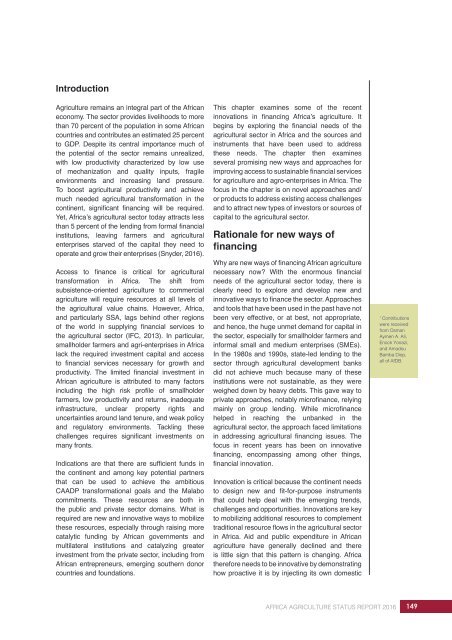AFRICA AGRICULTURE STATUS REPORT 2016
AASR-report_2016-1
AASR-report_2016-1
Create successful ePaper yourself
Turn your PDF publications into a flip-book with our unique Google optimized e-Paper software.
Introduction<br />
Agriculture remains an integral part of the African<br />
economy. The sector provides livelihoods to more<br />
than 70 percent of the population in some African<br />
countries and contributes an estimated 25 percent<br />
to GDP. Despite its central importance much of<br />
the potential of the sector remains unrealized,<br />
with low productivity characterized by low use<br />
of mechanization and quality inputs, fragile<br />
environments and increasing land pressure.<br />
To boost agricultural productivity and achieve<br />
much needed agricultural transformation in the<br />
continent, significant financing will be required.<br />
Yet, Africa’s agricultural sector today attracts less<br />
than 5 percent of the lending from formal financial<br />
institutions, leaving farmers and agricultural<br />
enterprises starved of the capital they need to<br />
operate and grow their enterprises (Snyder, <strong>2016</strong>).<br />
Access to finance is critical for agricultural<br />
transformation in Africa. The shift from<br />
subsistence-oriented agriculture to commercial<br />
agriculture will require resources at all levels of<br />
the agricultural value chains. However, Africa,<br />
and particularly SSA, lags behind other regions<br />
of the world in supplying financial services to<br />
the agricultural sector (IFC, 2013). In particular,<br />
smallholder farmers and agri-enterprises in Africa<br />
lack the required investment capital and access<br />
to financial services necessary for growth and<br />
productivity. The limited financial investment in<br />
African agriculture is attributed to many factors<br />
including the high risk profile of smallholder<br />
farmers, low productivity and returns, inadequate<br />
infrastructure, unclear property rights and<br />
uncertainties around land tenure, and weak policy<br />
and regulatory environments. Tackling these<br />
challenges requires significant investments on<br />
many fronts.<br />
Indications are that there are sufficient funds in<br />
the continent and among key potential partners<br />
that can be used to achieve the ambitious<br />
CAADP transformational goals and the Malabo<br />
commitments. These resources are both in<br />
the public and private sector domains. What is<br />
required are new and innovative ways to mobilize<br />
these resources, especially through raising more<br />
catalytic funding by African governments and<br />
multilateral institutions and catalyzing greater<br />
investment from the private sector, including from<br />
African entrepreneurs, emerging southern donor<br />
countries and foundations.<br />
This chapter examines some of the recent<br />
innovations in financing Africa’s agriculture. It<br />
begins by exploring the financial needs of the<br />
agricultural sector in Africa and the sources and<br />
instruments that have been used to address<br />
these needs. The chapter then examines<br />
several promising new ways and approaches for<br />
improving access to sustainable financial services<br />
for agriculture and agro-enterprises in Africa. The<br />
focus in the chapter is on novel approaches and/<br />
or products to address existing access challenges<br />
and to attract new types of investors or sources of<br />
capital to the agricultural sector.<br />
Rationale for new ways of<br />
financing<br />
Why are new ways of financing African agriculture<br />
necessary now? With the enormous financial<br />
needs of the agricultural sector today, there is<br />
clearly need to explore and develop new and<br />
innovative ways to finance the sector. Approaches<br />
and tools that have been used in the past have not<br />
been very effective, or at best, not appropriate,<br />
and hence, the huge unmet demand for capital in<br />
the sector, especially for smallholder farmers and<br />
informal small and medium enterprises (SMEs).<br />
In the 1980s and 1990s, state-led lending to the<br />
sector through agricultural development banks<br />
did not achieve much because many of these<br />
institutions were not sustainable, as they were<br />
weighed down by heavy debts. This gave way to<br />
private approaches, notably microfinance, relying<br />
mainly on group lending. While microfinance<br />
helped in reaching the unbanked in the<br />
agricultural sector, the approach faced limitations<br />
in addressing agricultural financing issues. The<br />
focus in recent years has been on innovative<br />
financing, encompassing among other things,<br />
financial innovation.<br />
Innovation is critical because the continent needs<br />
to design new and fit-for-purpose instruments<br />
that could help deal with the emerging trends,<br />
challenges and opportunities. Innovations are key<br />
to mobilizing additional resources to complement<br />
traditional resource flows in the agricultural sector<br />
in Africa. Aid and public expenditure in African<br />
agriculture have generally declined and there<br />
is little sign that this pattern is changing. Africa<br />
therefore needs to be innovative by demonstrating<br />
how proactive it is by injecting its own domestic<br />
1<br />
Contributions<br />
were received<br />
from Osman<br />
Aymen A. Ali,<br />
Enock Yonazi,<br />
and Amadou<br />
Bamba Diop,<br />
all of AfDB.<br />
<strong>AFRICA</strong> <strong>AGRICULTURE</strong> <strong>STATUS</strong> <strong>REPORT</strong> <strong>2016</strong><br />
149


